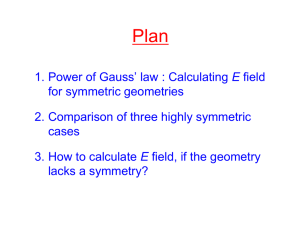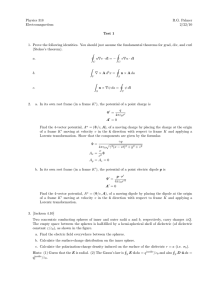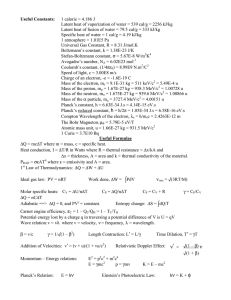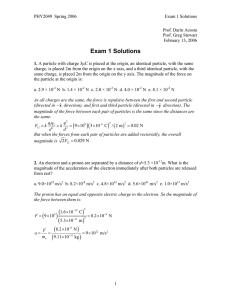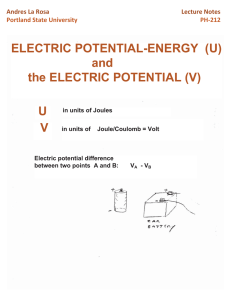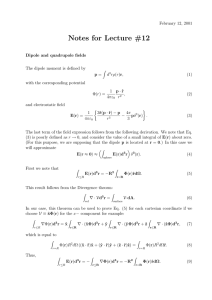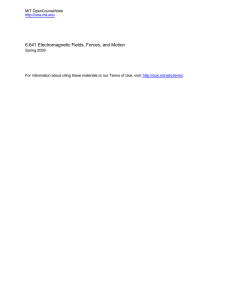Electric Field and Force
advertisement
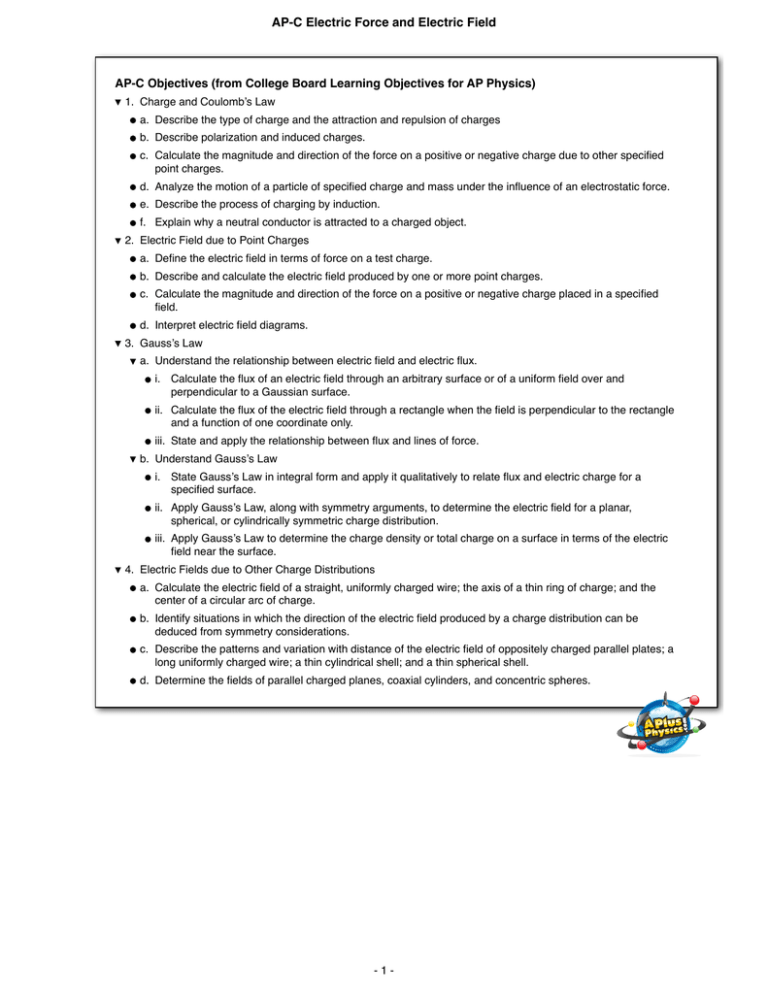
AP-C Electric Force and Electric Field AP-C Objectives (from College Board Learning Objectives for AP Physics) 1. Charge and Coulomb’s Law a. Describe the type of charge and the attraction and repulsion of charges b. Describe polarization and induced charges. c. Calculate the magnitude and direction of the force on a positive or negative charge due to other specified point charges. d. Analyze the motion of a particle of specified charge and mass under the influence of an electrostatic force. e. Describe the process of charging by induction. f. Explain why a neutral conductor is attracted to a charged object. 2. Electric Field due to Point Charges a. Define the electric field in terms of force on a test charge. b. Describe and calculate the electric field produced by one or more point charges. c. Calculate the magnitude and direction of the force on a positive or negative charge placed in a specified field. d. Interpret electric field diagrams. 3. Gauss’s Law a. Understand the relationship between electric field and electric flux. i. Calculate the flux of an electric field through an arbitrary surface or of a uniform field over and perpendicular to a Gaussian surface. ii. Calculate the flux of the electric field through a rectangle when the field is perpendicular to the rectangle and a function of one coordinate only. iii. State and apply the relationship between flux and lines of force. b. Understand Gauss’s Law i. State Gauss’s Law in integral form and apply it qualitatively to relate flux and electric charge for a specified surface. ii. Apply Gauss’s Law, along with symmetry arguments, to determine the electric field for a planar, spherical, or cylindrically symmetric charge distribution. iii. Apply Gauss’s Law to determine the charge density or total charge on a surface in terms of the electric field near the surface. 4. Electric Fields due to Other Charge Distributions a. Calculate the electric field of a straight, uniformly charged wire; the axis of a thin ring of charge; and the center of a circular arc of charge. b. Identify situations in which the direction of the electric field produced by a charge distribution can be deduced from symmetry considerations. c. Describe the patterns and variation with distance of the electric field of oppositely charged parallel plates; a long uniformly charged wire; a thin cylindrical shell; and a thin spherical shell. d. Determine the fields of parallel charged planes, coaxial cylinders, and concentric spheres. -1- Charge and Coulomb's Law Electric Charge AP-C Objectives (from College Board Learning Objectives for AP Physics) Electric charge (q) is a fundamental property of certain particles. The smallest amount of isolatable charge is the elementary charge (e), equal to 1.6×10-19 coulombs. Charge can be positive or negative. 1. Charge and Coulomb’s Law a. Describe the type of charge and the attraction and repulsion of charges b. Describe polarization and induced charges. c. Calculate the magnitude and direction of the force on a positive or negative charge due to other specified point charges. Atomic Particles d. Analyze the motion of a particle of specified charge and mass under the influence of an electrostatic force. Conductors and Insulators protons have a charge of +1e electrons have a charge of −1e neutrons are neutral Atoms with an excess of protons or electrons are known as ions. e. Explain the process of charging by induction. f. Explain why a neutral conductor is attracted to a charged object. 2. Electric Field due to Point Charges a. Define the electric field in terms of force on a test charge. Charges can move freely in conductors. Charges cannot move freely in insulators. b. Describe and calculate the electric field produced by one or more point charges. c. Calculate the magnitude and direction of the force on a positive or negative charge placed in a specified field. Polarization and Electric Dipole Moment d. Interpret electric field diagrams. Electric Force and Coulomb’s Law E= conductor 1 q 4πε0 r 2 + + + + + + + + + + - - + insulator + + + + + + ro d N im 2 ed 2 ed ε0 = 8.85 × 10−12 C arg F = qE 1 q1q2 4πε0 r 2 arg F q F= ch E= Like charges repel, opposite charges attract. ch The electric field describes the amount of electrostatic force observed by a charge placed at a point in the field per unit charge. The electric field vector points in the direction a positive test charge would feel a force. Electric field strength is measured in N/C, which are equivalent to V/m. ro d Electric Field (E) When a charged object is brought near a conductor, the electrons in the conductor are free to move. When a charged object is brought near an insulator, the electrons are not free to move, but they may spend a little more time on one side of their orbit than another, creating a net separation of charge in a process known as polarization. The distance between the shifted positive and negative charges, multiplied by the charge, is known as the electric dipole moment. + + + + + + + + + + + -+ -+ -+ -+ -+ -+ -+ Electric field lines indicate the direction of the electric force on a positive test charge. Conduction and Induction Charging by contact is known as conduction. If a charged conductor is brought into contact with an identical neutral conductor, the net charge will be shared across the two conductors. Charging an object without placing it in contact with another charged object is known as induction. Electric Field due to Multiple Point Charges The electric field follows the law of superposition. In order to determine the electric field due to multiple point charges, add up the electric field due to each of the individual charges. Sample Problem: E Field due to Point Charges Find the electric field at the origin due to the three point charges shown. y (m) 9 8 +2C 7 6 E1 = 1 q 1 (2) = =< 0,−2.81× 108 > 4πε0 r 2 4πε0 82 E2 = 1 q 1 (1) = = 1.13× 109 N C → 4πε0 r 2 4πε0 ( 22 + 22 )2 E2 =< −1.13× 109 N C × cos 45°,−1.13× 109 N C × sin 45° >→ 5 E2 =< −7.95 × 108 ,−7.95 × 108 > N C 4 3 E3 = +1C 2 -2C 2 3 4 5 6 Etot =< −5.14 × 108 ,−1.08 × 109 > N C 1 q 1 2 = =< 2.81× 108 ,0 > N C 4πε0 r 2 4πε0 82 1 1 Etot = E1 + E2 + E3 → 7 8 x (m) 9 Sample Problem: Where is the E Field Zero? Determine the x-coordinate where the electric field is zero using the diagram. r Etot = E1 + E2 = 1 q1 4πε0 r 2 E2 = 1 q2 4πε0 (11− r)2 11-r +1C +2C -7 -6 -5 -4 -3 -2 -1 E1 = 0 1 2 3 4 5 x (m) 6 7 1 k= 4πε0 1 q1 1 q2 k(1) k(2) − ⎯ ⎯⎯→ 2 − = 0 → r 2 + 22r − 121 = 0 → r = 4.56 4πε0 r 2 4πε0 (11− r)2 r (11− r)2 x = −6 + 4.56 = −1.44 -2- Electric Fields due to Other Charge Distributions 1 Charge Densities AP-C Objectives (from College Board Learning Objectives for AP Physics) 1. Electric Fields due to Continuous Charge Distributions Linear Charge Density λ= ΔQ ΔL Surface Charge Density σ= ΔQ ΔA Volume Charge Density ρ= ΔQ ΔV a. Calculate the electric field of a straight, uniformly charged wire; the axis of a thin ring of charge; and the center of a circular arc of charge. b. Identify situations in which the direction of the electric field produced by a charge distribution can be deduced from symmetry considerations. E-Field Due to a Thin Uniform Semicircle of Charge A thin insulating semicircle of charge Q with radius R is centered around point C. Determine the electric field at point C due to the semicircle of charge. Symmetry Arguments Horizontal component will cancel out since the charge is uniformly distributed, so we only need to worry about the vertical component of the electric field. dE y = θ=π 1 dQ 1 λRdθ sinθ ⎯dQ=λRdθ ⎯⎯⎯ → ∫ dE y = ∫ sinθ dθ → 2 θ=0 4πε 4πε0 R R2 0 θ=π π λ λ 2λ λ Ey = sinθ dθ → E y = (− cosθ) 0 = = ∫ θ=0 4πε0 R 4πε0 R 4πε0 R 2πε0 R λ= ΔQ Q = ΔL πR E Field Due to a Thin Straight Insulating Wire Find the electric field some distance d from a long straight insulating rod of length L at a point P which is perpendicular to the wire and equidistant from each end of the wire. λ= Strategy 1. Divide the total charge Q into smaller charges ΔQ. 2. Find the electric field due to each ΔQ. 3. Find the total electric field by adding up the individual electric fields due to each ΔQ. 4. Realize the y-component of the electric field is 0 due to symmetry arguments. Ei = Ei cosθi = x 1 ΔQ ri = yi2 +d 2 cosθi ⎯ ⎯⎯⎯⎯⎯ → d d 2 cosθi = = 4πε0 ri 2 2 ri yi +d Ei = 1 ΔQ 2 4πε0 ( yi + d 2 ) Ei = y= L2 dQ / L 1 dQdy dy 3 → Ex = ∫ 3 → 2 2 2 y=− L2 4πε 4πε0 L( y 2 + d 2 ) 2 ( y + d ) 0 i x x d y +d 2 i 2 1 dΔQ ΔQ= QL dy → 3 ⎯ ⎯⎯⎯ 2 2 2 4πε0 ( y + d ) i = dx x ∫ 2 2 23 = a2 a2 +x 2 +C dQ / L L2 dy ( a +x ) Ex = ⎯ ⎯⎯⎯⎯⎯⎯⎯ → 3 4πε0 ∫− L2 ( y 2 + d 2 ) 2 ⎛ dQ / L y ⎜ Ex = 1 2 2 4πε0 ⎜ d ( y + d 2 ) 2 ⎝ Ex = ⎞ Q/ L ⎡ L/2 −L / 2 ⎤ ⎟= ⎢ 1 − 1 ⎥ → 2 2 ⎟ 4πε0 d ⎢⎣ (( L2 ) + d ) 2 (( −2L )2 + d 2 ) 2 ⎥⎦ − L2 ⎠ L 2 Q/ L L Q 1 = 4πε0 d (( L2 )2 + d 2 ) 2 4πε d ( L )2 + d 2 2 0 What is the E Field if the rod is infinite? Q ⎛ ⎞ λ= Q Q Q λ L Ex = lim ⎜ = = ⎯ ⎯⎯ → Ex = ⎟ L 2 ⎟ L→∞ ⎜ L 2 4πε d( ) 2πε dL 2πε d 2 0 0 0 ⎝ 4πε0 d ( 2 ) + d ⎠ Note that Q approaches infinity as L approaches infinity! What is the E field if the distance d is infinite? ⎛ Q Ex = lim ⎜ d→∞ ⎜ L ⎝ 4πε0 d 2 () ⎞ ⎟= Q 2 2 2 ⎟ + d ⎠ 4πε0 d Acts like the E-field of a point charge! -3- Q L Electric Fields due to Other Charge Distributions 2 Charge Densities AP-C Objectives (from College Board Learning Objectives for AP Physics) 1. Electric Fields due to Continuous Charge Distributions Linear Charge Density λ= ΔQ ΔL Surface Charge Density σ= ΔQ ΔA Volume Charge Density ρ= ΔQ ΔV a. Calculate the electric field of a straight, uniformly charged wire; the axis of a thin ring of charge; and the center of a circular arc of charge. b. Identify situations in which the direction of the electric field produced by a charge distribution can be deduced from symmetry considerations. Electric Field on the Axis of a Thin Ring of Charge λ= Find the electric field at a point on the axis (perpendicular to the ring) of a thin insulating ring of radius R that is uniformly charged as shown in the diagram. Q Q = L 2πR ΔQ = λRdφ Symmetry Arguments By symmetry, the only net electric field will be in the z-direction. Ei = Ei cosθi = Z 1 ΔQ 1 ΔQ z ri = z 2 + R 2 cosθi ⎯ ⎯⎯⎯⎯⎯ → Ei = 1 → z z 2 2 2 2 Z cosθ = = 4πε0 ri 4πε0 (z + R ) (z + R 2 ) 2 i 2 2 ri z +R 1 z 1 z ΔQ=λRdφ Ei = → Ez = 3 ΔQ ⎯ ⎯⎯⎯ 3 Z 4πε0 (z 2 + R 2 ) 2 4πε0 (z 2 + R 2 ) 2 Ez = ∫ φ=2π φ=0 λR dφ = φ=2π 1 z dφ → 3 λR ∫ φ=0 4πε0 (z 2 + R 2 ) 2 Q λ= 1 z 1 zQ 2πR → Ez = 3 λR(2π) ⎯ ⎯⎯ 3 4πε0 (z 2 + R 2 ) 2 4πε0 (z 2 + R 2 ) 2 Electric Field Due to a Uniformly Charged Disk Find the electric field due to a uniformly charged insulating disk of radius R at a point P perpendicular to the disk as shown in the diagram. σ= Symmetry Arguments Q Q = A πR 2 By symmetry, the only net electric field will be in the z-direction. ΔQ = σΔA = σ2πriΔr zΔQi 1 1 zσ2πri dr ΔQ=σ 2πri dr Ei = 3 ⎯ ⎯⎯⎯→ E z = ∫ 3 → Z 4πε0 (z 2 + r 2 ) 2 4πε0 (z 2 + r 2 ) 2 i i σz Ez = 2ε0 Ez = σz 1 z 2 + R2 du σz ⎛ −2 ⎞ ∫r=0 (z 2 + r 2 ) 23 ⎯ ⎯⎯→ Ez = 2ε0 2 ∫u=z2 u 23 = 4ε0 ⎜⎝ u 12 ⎟⎠ i R rdr z 2 + R2 u=z 2 +r 2 du=2rdr → z2 ⎞ ⎞ σz ⎛ −2 −2 ⎞ σz ⎛ 1 1 σ ⎛ z − ⎟= − → Ez = 1− ⎜ ⎜ ⎟ ⎜ ⎟ 2 2 2 2 2 2 4ε0 ⎝ z + R z ⎠ 2ε0 ⎝ z 2ε0 ⎝ z +R ⎠ z +R ⎠ What is the E field if the disc is infinite (an infinite plane)? lim R→∞ ⎞ σ ⎛ z σ 1− = ⎜ ⎟ 2 2 2ε0 ⎝ z + R ⎠ 2ε0 Electric Field due to a Finite Charged Rod Find the electric field due to a finite uniformly charged rod of length L lying on its side at some distance d away from the end of the rod. L Symmetry Arguments d P By symmetry, the only electric field will be in the x-direction. Q λ= x Q → ΔQ = λΔx → dQ = λdx L d+ L dx λ ⎛ −1⎞ → Ex = 4πε0 ⎜⎝ x ⎟⎠ d x2 Ei = x=d+ L 1 ΔQ 1 dQ dQ=λdx 1 λdx λ → Ex = ∫ ⎯ ⎯⎯→ Ex = ∫ = 2 2 x=d 4πε0 x 4πε0 x 4πε0 x 2 4πε0 Ex = λ ⎛ −1 −1⎞ λ ⎛ −d + d + L ⎞ λ ⎛ L ⎞ λ=Q/ L Q L 1 Q − = = ⎯ ⎯⎯ → Ex = → Ex = 4πε0 ⎜⎝ d + L d ⎟⎠ 4πε0 ⎜⎝ d(d + L) ⎟⎠ 4πε0 ⎜⎝ d(d + L) ⎟⎠ 4πε0 L d(d + L) 4πε0 d(d + L) x -4- ∫ d+ L d → Ex Gauss's Law AP-C Objectives (from College Board Learning Objectives for AP Physics) 1. Gauss’s Law a. Understand the relationship between electric field and electric flux. i. Calculate the flux of an electric field through an arbitrary surface or of a uniform field over and perpendicular to a Gaussian surface. ii. Calculate the flux of the electric field through a rectangle when the field is perpendicular to the rectangle and a function of one coordinate only. iii. State and apply the relationship between flux and lines of force. b. Understand Gauss’s Law i. State Gauss’s Law in integral form and apply it qualitatively to relate flux and electric charge for a specified surface. ii. Apply Gauss’s Law, along with symmetry arguments, to determine the electric field for a planar, spherical, or cylindrically symmetric charge distribution. iii. Apply Gauss’s Law to determine the charge density or total charge on a surface in terms of the electric field near the surface. Electric Flux Through Open Surfaces Electric Flux Through Closed Surfaces Electric Flux (Φ) is the amount of electric field penetrating a surface. dΦ = E • dA = EdAcosθ → Φ = ∫ dΦ = ∫ E • dA Convention: Normals to closed surfaces point from the inside to the outside. Total flux through the closed surface is positive if there is more flux from inside to outside than outside to inside, and negative if there is more flux from outside to inside than inside to outside. dA dA E A Φ = ∫ dΦ = ∫ E • dA dA Integral over closed surface Derivation of Gauss’s Law Gauss’s Law Consider a point charge inside a spherical shell of radius R. Determine the flux through the sphere. θ=0 dΦ = E • dA = EdAcosθ ⎯cosθ=1 ⎯⎯ → dΦ = EdA → A=4πR Φ = ∫ dΦ = ∫ E dA = E ∫ dA = EA ⎯ ⎯⎯→ 2 Q E 2 r̂ Q Φ= ∫ E • dA = enclosed ε0 dA +Q ⎛ Q ⎞ Q 4πε0 R Φ = 4πR 2 E ⎯ ⎯⎯⎯ → Φ = 4πR 2 ⎜ = → 2⎟ ⎝ 4πε0 R ⎠ ε0 Q Gauss’s Law! Φ= ∫ E • dA = enclosed ε0 E= Useful for finding the electric field due to charge distributions for cases of: 1) Spherical symmetry 2) Cylindrical symmetry 3) Planar symmetry R Sample Problem: Electric Field due to a Thin Hollow Shell Q ro Consider a thin hollow shell of uniformly distributed charge Q. Find the electric field inside and outside the sphere. ri Choose a “Gaussian Surface” as a sphere (first inside the shell of charge, then outside the shell of charge). By symmetry, the electric field at all points on the Gaussian spheres must be the same, and it must point radially in or out. R Inside the shell of charge (ri<R): Q Q Qenc Qenc =0 → 4πR 2 E = enc → E = ⎯ ⎯⎯ →E =0 ∫ E • dA = enclosed ε0 ε0 4πε0 R 2 E 1 r2 Outside the shell of charge (ro>R): Q Q Qenc → 4πR 2 E = enc → E = ∫ E • dA = enclosed ε0 ε0 4πε0 R 2 Same answer as if all the charge Q was placed at a point in the center of the sphere. r R Sample Problem: Electric Field due to an Infinite Plane Consider an infinite plane of uniform charge density σ. Determine the electric field due to the plane. A E Choose a “Gaussian Surface” as a cylinder as shown in the diagram. By symmetry, the electric field at all points on the cylinder must point perpendicular to the plane through the caps of the cylinder. d ∫ E • dA = ΦE + ΦE top Qenc σ= QA σ A symmetry ⎯Q=σ ⎯⎯ → ΦE + ΦE + ΦE = ⎯ ⎯⎯⎯ → A top bottom sides ε0 ε0 Φ Esides =0 bottom 2 σ A Φ Etop = EA σA σ = ⎯ ⎯⎯⎯→ 2EA = →E= ε0 Φ Ebottom = EA ε0 2ε0 Note: There is NO dependence on distance from the plane! d TOP Sample Problem: Electric Field Between Parallel Charged Planes Find the electric field surrounding and in between two oppositely-charged parallel planes or plates Strategy: Use E Field from a single infinite plane with surface charge density σ to derive solution by adding the electric fields from each of the planes using the superposition principle. Note that this is not accurate near the ends of the planes or plates. E 2 BOTTOM E 0 E E 2 0 2 0 E Sample Problem: Electric Field due to Infinite Line of Charge Determine the electric field at a distance R from an infinitely long line of uniform charge density λ. R Choose a “Gaussian Surface” as a cylinder centered around the line of charge as shown. By symmetry, the electric field at all points on the cylinder must point radially in or out. 2πRLE = Qenc Q Q ΦCyl =2πRLE → Φ L + Φ R + ΦCyl = enc ⎯Φsymmetry ⎯⎯⎯ → ΦCyl = enc ⎯ ⎯⎯⎯ → L +Φ R =0 ε0 ε0 ε0 Qenc λ= QL λL λ ⎯Q=λL ⎯⎯ → 2πRLE = →E= ε0 ε0 2πε0 R 0 2 0 2 0 bottom Same answer as that reached using Coulomb’s Law -5- NET E 2 top E ∫ E • dA = 0 Q A 0 E 0 E 0

